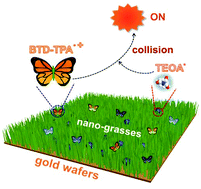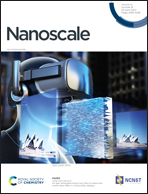A mass-amplifying electrochemiluminescence film (MAEF) for the visual detection of dopamine in aqueous media†
Abstract
A bright and metal-free mass-amplifying electrochemiluminescence film (MAEF) performing in aqueous media was reported for the first time. Systematic studies demonstrated that the film substrates have a remarkable influence on the electrochemiluminescence (ECL) performance. Gold substrates promote ECL reactions and the subsequent radiative decay process simultaneously, affording an unconventional 507-fold ECL enhancement. Such a gold-enhanced MAEF is opposite to ECL systems previously reported, in which the use of gold electrodes normally results in decreased ECL intensity due to passivation of the gold surface by oxide formation. More importantly, the ECL intensity of the MAEF is linearly amplified through facilely regulating luminogen loading. Morphological analysis reveals that the film consists of grass-like nanowires with a diameter of 57 nm, which facilitate electrical communication between the luminogen, electrode, and supporting electrolyte, giving rise to the mass-amplifying ECL. The bright ECL of the solid film in aqueous media can be readily observed by the naked eye, entirely different from visible ECL systems reported in which ruthenium complexes dissolved/dispersed in solution are used as the luminogens. The film is further utilized to detect dopamine (DA), an important biomolecule related to nervous diseases, in aqueous media, with a low detection limit of 3.3 × 10−16 M. Furthermore, a facile method based on grayscale analysis of ECL images (GAEI) of the film was developed for visual and ultrasensitive DA detection in aqueous media.



 Please wait while we load your content...
Please wait while we load your content...